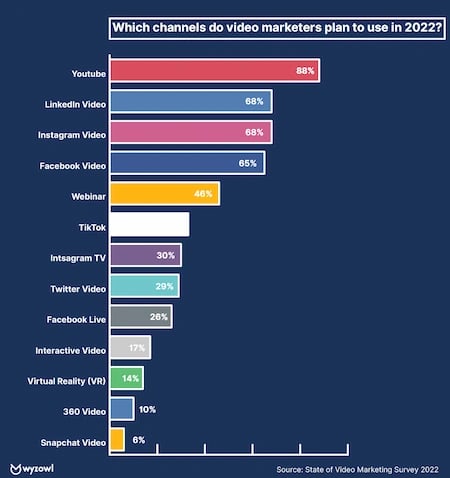Drive Involvement: Next-Level Video Marketing Approaches Disclosed
Wiki Article
Understanding the Art of Video Advertising And Marketing: Implementing Proven Techniques to Enhance Target Market Connection and Drive Company Success
In the digital landscape of today, video clip advertising and marketing has emerged as an effective device for businesses to connect with their target audiences and accomplish their tactical objectives. By checking out the subtleties of audience segmentation, storytelling strategies, and data-driven optimization, companies can unlock the complete potential of video clip marketing to improve target market link and drive business success.
Recognizing Your Target Market
To efficiently implement video clip advertising and marketing techniques, it is crucial to have a deep understanding of your target audience's choices and actions. By thoroughly comprehending what reverberates with your audience, you can develop video content that is customized to their interests, ultimately leading to greater interaction and conversion rates. Performing extensive market research, examining group data, and monitoring online interactions are necessary action in acquiring insights into your target market's wants and needs.Moreover, recognizing your audience includes greater than just demographics; it encompasses psychographics, such as attitudes, rate of interests, and values (Video Marketing). By delving right into the psychographic account of your target market, you can refine your video clip web content to line up with their beliefs and aspirations, promoting a more powerful psychological link
Crafting Engaging Stories

Enhancing Video Clip Search Engine Optimization
When aiming to improve the presence and reach of your video clip content online, mastering the art of enhancing Video clip search engine optimization is critical. Video search engine optimization entails strategically optimizing your videos to place higher in search engine results, making them much more discoverable to your target audience. To start, carrying out keyword study to recognize high-traffic and relevant key phrases is critical. Incorporating these key words naturally right into your video clip tags, titles, and descriptions can considerably enhance your video's searchability.
Leveraging Social Media Site Platforms

Each social media platform offers special advantages for video clip advertising and marketing. Facebook, for example, with its vast customer base, supplies a versatile space for sharing various types of video clip material, from tutorials to behind-the-scenes glimpses. Instagram, on the various other hand, flourishes on aesthetically appealing video clips that resonate with its visually-driven target market. Twitter's succinct nature makes it ideal for sharing brief, impactful video clips, while LinkedIn accommodates a more properly oriented audience, making it a valuable system for business-related video web content.
Including a diverse social media sites technique that customizes video clip content to fit the subtleties of each platform can substantially boost brand exposure, involvement, and eventually, drive company success in the digital world.
Studying Efficiency Metrics
To properly determine the impact and success of your video advertising efforts across various social media sites systems, it is important to assess performance metrics that offer beneficial understandings into audience interaction and project performance. Video Marketing. By tracking key performance signs (KPIs) such as sights, suches as, shares, remarks, click-through rates, and conversion rates, companies can examine the reach and vibration of their video content. Analytics tools offered by platforms like YouTube, Facebook, and Instagram use thorough information on target market demographics, viewing behavior, and engagement metrics, enabling marketing professionals to maximize their video clip approaches for far better outcomesAlong with platform-specific metrics, it is important to set specific objectives and standards for each and every video clip project to examine its efficiency efficiently. Frequently keeping an eye on and examining these efficiency metrics not only helps in understanding what works best for your target market yet likewise offers important insights for refining future video clip web content and advertising techniques. Ultimately, by leveraging performance information to make educated decisions, businesses can boost target market connection, drive business success, and make the most of the ROI of their video clip advertising and marketing efforts.
Conclusion
Finally, grasping the art of video advertising and marketing needs a deep understanding of your audience, crafting engaging storylines, optimizing video clip SEO, leveraging social media sites systems, and analyzing efficiency metrics. By executing these proven methods, companies can boost audience link and drive success. It is vital to continuously adjust and refine video clip marketing approaches to stay pertinent and engage with target markets efficiently.Video clip SEO includes strategically enhancing your video clips to rank greater in search engine results, making them more visible to your target audience. Ensuring that your video web content is of high quality, appropriate to your target market, and optimized for various tools can improve individual experience and boost the possibility of your videos being shared and connected to by various other internet sites. In addition, advertising your videos throughout numerous systems can help drive great site traffic and enhance your video's total Search engine optimization efficiency. Twitter's concise nature makes it suitable for sharing brief, impactful video clips, while LinkedIn provides to a much more professionally oriented target market, making it a valuable platform for business-related video clip web content.
In verdict, grasping the art of video advertising and marketing needs a deep understanding of your audience, crafting compelling stories, maximizing video clip Search engine optimization, leveraging social media platforms, and analyzing performance metrics.
Report this wiki page